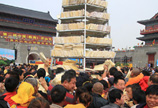Lessons of the storm
By Peng Yining, Jiang Xueqing and Hu Yongqi (China Daily) Updated: 2012-08-14 08:22Rainstorm survival tips
Before a storm
Move to a higher position from dilapidated or low-lying buildings.
Put sandbags around the door if you live in a bungalow or on the first floor.
Keep that electric circuits and cookers are isolated.
Ensure stocks of food, medicines and other daily necessities.
During a storm
Stay at home. If you have to go out, skirt any flooded areas, stay close to buildings and keep an eye out for loose drain covers.
Switch off the electricity if the water enters your home.
Driving in a storm
Try to skirt flooded areas. If that proves impossible, engage a low gear and dive slowly and steadily through the affected area. Try not to stop or change gears.
Don't try to drive through a flooded area alone.
Don't stay in the car during an especially heavy downpour. Unlock the doors and be prepared to get out at any minute. Consider pulling over and leaving the vehicle, don't wait until the water level makes the road impassible.
Stay calm if the engine stalls when driving through a flooded area. You will not be in danger as long as the water does not rise above the windows. Don't restart the engine.
If you are endangered by mountain torrents
Climb to an elevated slope or highland via a projected route if you have time.
Use boats, rafts, doors and wooden beds as transport if you are surrounded by water.
Climb a tree or scale a high wall. Try to gain access to tall buildings or rooftops and wait to be rescued. Don't try to escape by swimming on your own.
Avoid crossing rivers in mountainous areas that are constantly inundated by heavy rains. Look out for landslides and falling stones.
Avoid going close to damaged power lines or high-voltage towers.
Take medicines to help prevent illness when the flood has receded.
How to avoid being struck by lightning
Stay away from open areas, large billboards and antennas.
Don't attempt to use a cellphone or hide under trees, telegraph poles or tower cranes.
Don't stand next to iron railings, metal clotheslines or railroads. Avoid metals that conduct electricity.
Don't use an umbrella with a metal tip. If involved in sports, relinquish contact with equipment that contains iron, such as badminton rackets and golf clubs.
Remove your eyeglasses, watches and belts.
Don't stand on top of mountains or buildings. Keep away from chimneys and trees standing alone.
Don't ride a bike or a motorcycle.
Avoid water-related activities, including fishing, swimming or rowing a boat.
If possible, find a building with a lightning rod or an enclosure with a metal roof. Cars provide good shelter from lightning.
If you don't have access to any of the above shelters, take cover in low-lying areas as quickly as possible. Place your feet together, squat down and hold your knees with both hands. Don't let your arms touch the ground and don't lie on the ground.
Wear rubber-soled sneakers and carry an insulated raincoat when traveling during the rainy season. Avoid carrying keys and other metal objects, if possible. Don't camp at the top of a mountain, on high hills or open ground. If sheltering in a cave, keep away from the entrance.
Turn off your cellphone. Don't stand at the edge of woods or near large rocks, and don't walk across open fields. Avoid crowding against one another or holding hands.
Rainstorm warning signals
In China, a storm is categorized as rainfall of at least 50 millimeters over a period of 24 hours. Storm warning signals come in four categories, with each represented by a different color.
Blue means the rainfall in a period of 12 hours will amount to at least 50 mm, or has already reached 50 mm and the rain is likely to continue;
Yellow means rainfall of at least 50 mm in a period of 6 hours, or has already reached 50 mm and the rain is likely to continue;
Orange means rainfall of at least 50 mm in a period of 3 hours, or has already reached 50 mm and the rain is likely to continue;
Red means the rainfall in a period of 3 hours will be at least 100 mm, or has already reached 100 mm and the rain is likely to continue.
How to escape from a sinking car
Stay calm and release your seatbelt as quickly as possible. Take care not to allow the belt to become tangled.
Open the side windows or doors. If they jam, try to break a window with an emergency hammer, the removable headrests or a fire extinguisher. Instead of hitting the middle of the window, aim for the edges, which are more fragile. Forget about the windshield, in most cases they are unbreakable.
Extreme water pressure may prevent you from opening a door if you attempt to do so before the pressure has equalized in and outside the vehicle. Equalization happens when the vehicle is almost full of water. Take a deep breath and push a door open.
Source: The Red Cross Society of China Shijiazhuang Branch
Contact the reporters at pengyining@chinadaily.com.cn, jiangxueqing@chinadaily.com.cn and huyongqi@chinadaily.com.cn
- Seven villagers murdered in N China
- China steps up tobacco control efforts
- Five jailed for separatism in Xinjiang
- Letter asks for leniency in poisoning case
- Antibiotics in surface water pose 'indirect health risk'
- Tianjin airport opens up transit link to Beijing
- High levels of antibiotics in China's major rivers
- China to dig tunnel for Asian rail system
- Bering strait line to US possible, experts say
- China: Stop oil rig harassment







